The Lenovo ThinkStation P8 tower is an extremely powerful workstation for the highest caliber duties with endless configuration options.
Lenovo’s top-of-the-line ThinkStation P8 is a tremendously powerful workstation that can handle the most demanding usage. The P8 is built around AMD’s Threadripper Pro platform. It supports 96 cores on a single CPU, far more than the 56 cores Intel supports on its Xeon W-class chips. It also supports two high-end GPUs, 1TB of RAM, and numerous internal storage drives.
As expected in this class, the ThinkStation P8 has many independent software vendor (ISV) certifications for popular design apps. These certifications elevate the value of this tower since Lenovo will work with you if you encounter any software issues.
Lenovo ThinkStation P8 Workstation Specifications
| Processor |
|
| Operating System | Windows 11 Pro |
| Graphics |
|
| Memory | Up to 8 x 128GB DDR5 4800MHz RDIMM ECC |
| Storage |
|
| Ports/Slots | Front:
Rear:
Optional Rear:
|
| Wireless |
|
| Dimensions | 435mm x 175mm x 508mm / 17.1″ x 6.9″ x 20.0″ – without feet |
| Weight | Up to 25.9kg / 57.1lbs |
| Sustainability | System
Packaging*
|
| Certifications/Registries |
|
| ThinkShield Security |
|
| Power Supply |
|
| ISV Certifications |
|
Lenovo ThinkStation P8 Build and Design
After working with legendary car maker Aston Martin on this chassis design, it’s little wonder that the Lenovo ThinkStation P8 looks flashier than most workstations in the lab. The red around the front bezel gives it a racy look and says it means business. The entire front panel is honeycombed for airflow.
This is a massive tower, at 17.1″ x 6.9″ x 20.0″ (without feet). It can be oriented upright or on its side. In a thoughtful touch, the ThinkStation logo can be rotated depending on the orientation. (We decided not to rotate it.)
The front ports include two 10Gbps USB-A ports, two 10Gbps USB-C ports, and a 3.5mm headphone/microphone jack. The power button is also here. Our unit also has an optional media card reader.
We’d like to see hot-swappable front drives on the next iteration of this workstation.
The other ports are around the back, where you’ll find 3.5mm line-in and line-out jacks, three 10Gbps USB-A ports, two USB 2.0 ports, a 20Gbps USB-C port, an optional Serial port, and two Ethernet jacks (1Gbps and 10Gbps). Of course, additional ports can be added via PCIe add-in cards.
This workstation doesn’t support redundant power supplies, as we’ve seen from some very high-end workstations, but the available 1000W and 1400W models are very potent, rated for 92% efficiency. Also visible back here are the upper and lower PCIe slots.
Lenovo ThinkStation P8 Serviceability
Servicing most components in this big workstation can be done without tools; surfaces or edges highlighted in red indicate where to put your hands or fingers.
The Threadripper Pro CPU is covered by a massive CPU cooler. Liquid cooling could probably wring more performance out of this beast, but mainstream vendors have stayed with air cooling.
The eight DIMM slots flanking the CPU have active cooling shrouds, and there are heatsinks all over the motherboard.
Even the power supply can be removed without tools. There is also a rear power button.
The single NVIDIA RTX A6000 graphics card is installed in the top PCIe slots; an additional card can be installed in the bottom slots. The CPU and the PCIe slots have dedicated, straight-through airflow channels.
Lenovo ThinkStation P8 Workstation Performance
Our test ThinkStation P8 had the following configuration:
- AMD Threadripper Pro 7995WX
- NVIDIA A6000 GPU
- 128GB RAM
We have the most powerful CPU and the minimum amount of RAM that would probably be paired with it. The RTX A6000 GPU is no longer the top dog in the workstation world – that honor belongs to the newer RTX 6000 Ada Generation – but it’s still extremely powerful and packs 48GB of memory. See our NVIDIA RTX 6000 Ada vs RTX A6000 Review.
Pricing will vary wildly by configuration – for example, the Threadripper Pro 7995WX adds a mere $22,689 over the 12-core Threadripper Pro 7945WX – so we aren’t providing price comparisons to other systems. A Lenovo channel partner is your best bet for purchasing this system.
We used the HP Z6 G5 A for performance comparison; it sports the same CPU and RAM but uses the RTX 6000 Ada Generation.
SPECworkstation 3
SPECworkstation3 specializes in benchmarks designed to test all key aspects of workstation performance. It uses over 30 workloads to test CPU, graphics, I/O, and memory bandwidth. The workloads fall into broader categories such as Media and Entertainment, Financial Services, Product Development, Energy, Life Sciences, and General Operations. We will list the broad-category results for each rather than the individual workloads. The results are an average of all the individual workloads in each category.
Subtests, where the ThinkStation showed an edge, suggest it has a mild CPU performance edge over the HP. GPU-limited tests, especially GPU Compute, obviously favored HP since it uses the newer RTX 6000 Ada.
| SPECworkstation 3 (Higher is better) | Lenovo ThinkStation P8 (Threadripper Pro 7995WX, RTX A6000) | HP Z6 G5 A (Threadripper Pro 7995WX, RTX 6000 Ada) |
| Media and Entertainment | 10.25 | 9.4 |
| Product Development | 11.28 | 11.91 |
| Life Sciences | 12.61 | 16.21 |
| Financial Services | 31.41 | 29.32 |
| Energy | 18.14 | N/A |
| General Operations | 3.67 | 3.56 |
| GPU Compute | 7.74 | 10.99 |
SPECviewperf 2020
Our first test is SPECviewperf 2020, the worldwide standard for measuring graphics performance of professional applications under the OpenGL and Direct X application programming interfaces. The viewsets (or benchmarks) represent graphics content and behavior from actual applications, without having to install the applications themselves. The newest version of this benchmark went through major updates late last year, including new viewsets taken from traces of the latest versions of 3ds Max, Catia, Maya, and Solidworks applications. In addition, they added support within all viewsets for both 2K and 4K resolution displays.
HP dominated these tests since it uses the newer NVIDIA card. The ThinkStation can be ordered with that same card (or even two), so we won’t comment on the GPU performance in the remaining GPU-specific tests.
| SPECviewperf2020 Viewsets (Higher is better) | Lenovo ThinkStation P8 (Threadripper Pro 7995WX, RTX A6000) | HP Z6 G5 A (Threadripper Pro 7995WX, RTX 6000 Ada) |
| 3dsmax-07 | 139.06 | 214.1 |
| Catia-06 | 106.99 | 138.21 |
| Creo-03 | 153.09 | 181.24 |
| Energy-03 | 42.84 | 87.03 |
| Maya-06 | 357.54 | 573.38 |
| Medical-03 | 67.42 | 131.97 |
| Snx-04 | N/A | 993.48 |
| Solidworks-05 | 215.69 | 301.27 |
Blender OptiX
Blender is an open-source 3D modeling application. This benchmark was run using the Blender Benchmark utility. The score is samples per minute, with higher being better.
| Blender OptiX (Samples per minute, Higher is better) | Lenovo ThinkStation P8 (Threadripper Pro 7995WX, RTX A6000) | HP Z6 G5 A (Threadripper Pro 7995WX, RTX 6000 Ada) |
| Monster | 2,459.7 | 6,753.6 |
| Junkshop | 1,501.8 | 3,155.86 |
| Classroom | 1,361.2 | 3,162.94 |
Luxmark
Another 3D benchmark we looked at is LuxMark, an OpenCL GPU benchmarking utility.
| Luxmark (Higher is better) | Lenovo ThinkStation P8 (Threadripper Pro 7995WX, RTX A6000) | HP Z6 G5 A (Threadripper Pro 7995WX, RTX 6000 Ada) |
| Hallbench | 21,277 | 32,102 |
| food | 7,987 | 14,530 |
OctaneBench
Up next was OctaneBench, a benchmarking utility for OctaneRender, another 3D renderer with RTX support similar to V-Ray.
| OctaneBench (Score, higher is better) | Kernel | Lenovo ThinkStation P8 (Threadripper Pro 7995WX, RTX A6000) | HP Z6 G5 A (Threadripper Pro 7995WX, RTX 6000 Ada) |
| Interior | Info channels | 18.56 | 45.22 |
| Interior | Direct lighting | 68.18 | 133.27 |
| Interior | Path tracing | 88.31 | 165.17 |
| Idea | Info channels | 11.79 | 27.06 |
| Idea | Direct lighting | 53.61 | 105.30 |
| Idea | Path tracing | 65.93 | 125.42 |
| ATV | Info channels | 29.20 | 70.72 |
| ATV | Direct lighting | 75.36 | 132.51 |
| ATV | Path tracing | 94.87 | 167.51 |
| Box | Info channels | 15.79 | 36.43 |
| Box | Direct lighting | 67.54 | 124.41 |
| Box | Path tracing | 76.27 | 135.52 |
Blackmagic RAW Speed Test
We have also started running Blackmagic’s RAW speed test, which tests video playback. The ThinkStation showed a slight edge in the CPU test.
| Blackmagic RAW Speed Test (Higher is better) | Lenovo ThinkStation P8 (Threadripper Pro 7995WX, RTX A6000) | HP Z6 G5 A (Threadripper Pro 7995WX, RTX 6000 Ada) |
| 8K CPU | 147 fps | 143 fps |
| 8K CUDA | 139 fps | 182 fps |
7-Zip Compression
Our next test is the built-in memory benchmark in the popular 7-Zip utility. The scores are similar enough to call this one a draw, suggesting that the CPU performance between these towers is similar.
| 7-Zip Compression Benchmark (Higher is better) | Lenovo ThinkStation P8 (Threadripper Pro 7995WX, RTX A6000) | HP Z6 G5 A (Threadripper Pro 7995WX, RTX 6000 Ada) |
| Current CPU Usage | 3,258% | 3,321% |
| Current Rating/Usage | 8.757 GIPS | 9.752 GIPS |
| Current Rating | 285.283 GIPS | 323.905 GIPS |
| Resulting CPU Usage | 3,288% | 3,321% |
| Resulting Rating/Usage | 8.552 GIPS | 9.714 GIPS |
| Resulting Rating | 281.198 GIPS | 322.627 GIPS |
| Decompressing | ||
| Current CPU Usage | 6,050% | 6,113% |
| Current Rating/Usage | 6.145 GIPS | 5.784 GIPS |
| Current Rating | 371.780 GIPS | 353.596 GIPS |
| Resulting CPU Usage | 6,067% | 6,121% |
| Resulting Rating/Usage | 6.125 GIPS | 5.724 GIPS |
| Resulting Rating | 371.583 GIPS | 350.375 GIPS |
| Total Rating | ||
| Total CPU Usage | 4,678% | 4,721% |
| Total Rating/Usage | 7.399 GIPS | 7.719 GIPS |
| Total Rating | 326.390 GIPS | 336.501 GIPS |
Blackmagic Disk Speed Test
We run the popular Blackmagic Disk Speed Test against the system’s primary storage drive. Ours seems to be pushing the limits of the PCIe Gen4 interface.
 UL Procyon AI Inference
UL Procyon AI Inference
UL’s Procyon estimates a workstation’s performance for professional apps. These tests are intended to be run on a GPU, and it’s hard to beat the HP’s RTX 6000 Ada here.
| UL Procyon Average Inference Times (ms, lower is better) | Lenovo ThinkStation P8 (RTX A6000 – Tensor RT) | Lenovo ThinkStation P8 (RTX A6000, Windows ML) | Lenovo ThinkStation P8 (Threadripper Pro 7995WX) | HP Z6 G5 A (RTX 6000 Ada) – Tensor RT | HP Z6 G5 A (RTX 6000 Ada) – Windows ML | HP Z6 G5 A (Threadripper Pro 7995WX) |
| MobileNet V3 | 0.40 | 0.67 | 4.84 | 0.42 | 0.51 | 3.57 |
| ResNet 50 | 1.35 | 1.54 | 8.23 | 1.06 | 0.94 | 6.25 |
| Inception V4 | 4.10 | 3.91 | 29.05 | 3.37 | 2.28 | 25.43 |
| DeepLab V3 | 3.41 | 12.89 | 26.74 | 2.78 | 13.46 | 25.25 |
| YOLO V3 | 4.13 | 6.60 | 36.24 | 2.71 | 4.04 | 33.37 |
| Real-ESRGAN | 124.73 | 123.55 | 2,877.69 | 83.80 | 85.73 | 2,891.39 |
| Overall Score | 1,258 | 846 | 130 | 1,597 | 1,204 | 149 |
y-cruncher
y-cruncher is a multi-threaded and scalable program that can compute Pi and other mathematical constants to trillions of digits. Since its launch in 2009, it has become a popular benchmarking and stress-testing application for overclockers and hardware enthusiasts. The ThinkStation lagged here for reasons unclear to us.
| y-cruncher (Total Computation time) | Lenovo ThinkStation P8 (Threadripper Pro 7995WX, RTX A6000) | HP Z6 G5 A (Threadripper Pro 7995WX, RTX 6000 Ada) |
| 1 billion digits | 10.642 seconds | 8.436 seconds |
| 2.5 billion digits | 26.234 seconds | 18.835 seconds |
| 5 billion digits | 54.787 seconds | N/A |
| 10 billion digits | 113.739 seconds | 72.856 seconds |
| 25 billion digits | 308.438 seconds | N/A |
Geekbench 6
Geekbench 6 is a cross-platform benchmark that measures overall system performance. The Geekbench Browser allows you to compare any system to it. Unlike the results from y-cruncher, the ThinkStation, and HP had similar CPU test results.
| Geekbench 6 (Higher is better) | Lenovo ThinkStation P8 (Threadripper Pro 7995WX, RTX A6000) | HP Z6 G5 A (Threadripper Pro 7995WX, RTX 6000 Ada) |
| CPU Single-Core | 2,741 | 2,655 |
| CPU Multi-Core | 23,575 | 24,519 |
| GPU | 200,992 | 319,290 |
Cinebench R23
This benchmark uses all CPU cores and threads to generate an overall score. The ThinkStation demonstrated a clear edge over the HP, with significantly better multi-core performance.
| Cinebench R23 (Higher is better) | Lenovo ThinkStation P8 (Threadripper Pro 7995WX, RTX A6000) | HP Z6 G5 A (Threadripper Pro 7995WX, RTX 6000 Ada) |
| Multi-Core | 112,974 | 100,562 |
| Single-Core | 1,836 | 1,709 |
Cinebench R24
We also started running the latest Cinebench test. Again, the ThinkStation had better CPU numbers.
| Cinebench R23 (Higher is better) | Lenovo ThinkStation P8 (Threadripper Pro 7995WX, RTX A6000) | HP Z6 G5 A (Threadripper Pro 7995WX, RTX 6000 Ada) |
| Multi-Core | 6,141 | 5,683 |
| Single-Core | 107 | 102 |
| GPU | 17,563 | 31,457 |
Conclusion
The ThinkStation P8 tower is an extremely powerful workstation for the highest caliber duties. Lenovo’s endless configurations allow it to be used for almost any task. As we expect from a workstation in this class, it’s designed for 24/7 use and is simple to service. This system provides ample room for expansion, ensuring long-term usefulness. It includes essential ISV certifications, robust security features, and enterprise support.
We found the ThinkStation P8 and the HP Z6 G5 A performed similarly when equipped with the 96-core Threadripper Pro 7995WX, suggesting that they are equally cooled. We consider this ThinkStation a good alternative to HP and vice versa.
Engage with StorageReview
Newsletter | YouTube | Podcast iTunes/Spotify | Instagram | Twitter | TikTok | RSS Feed

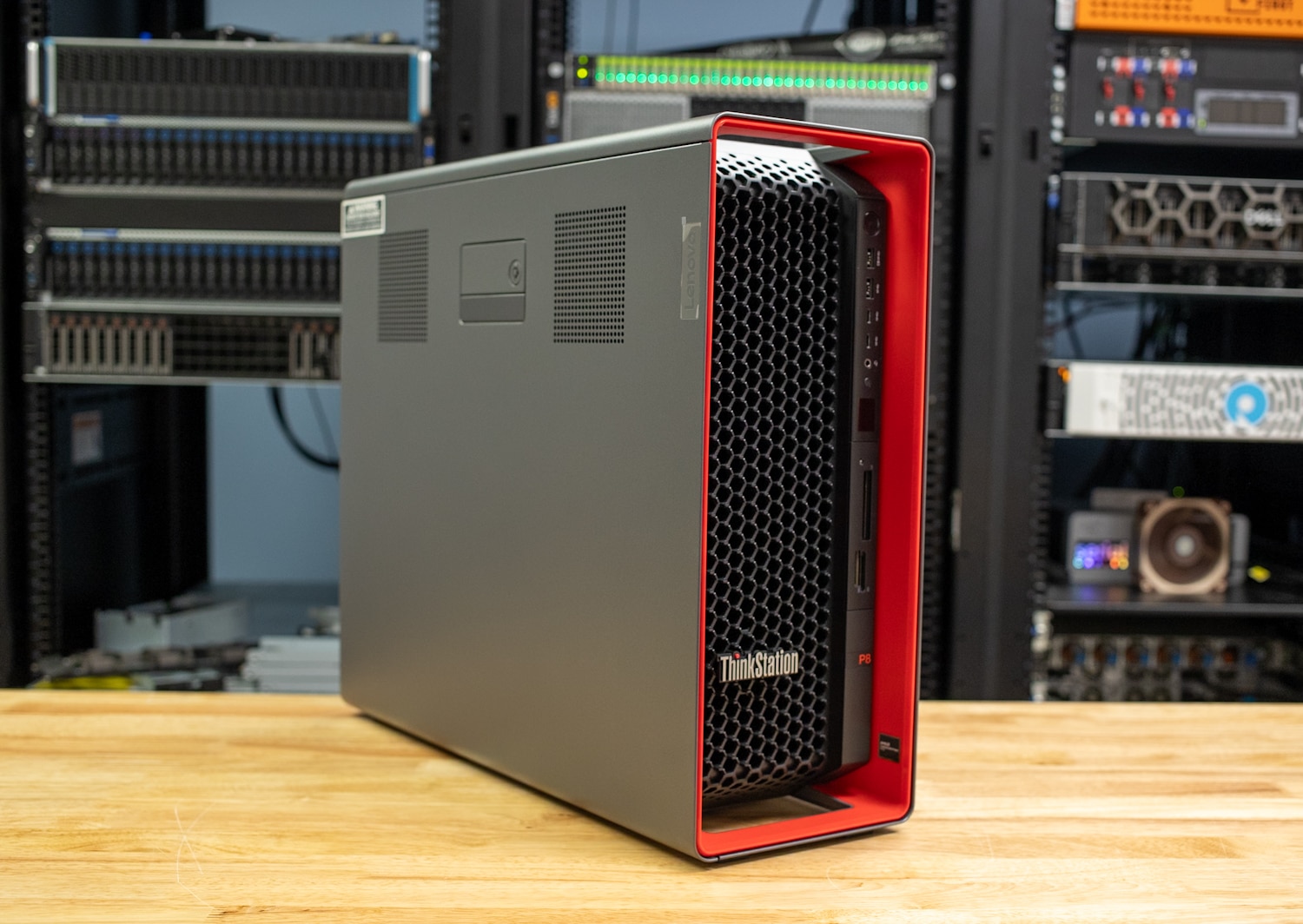
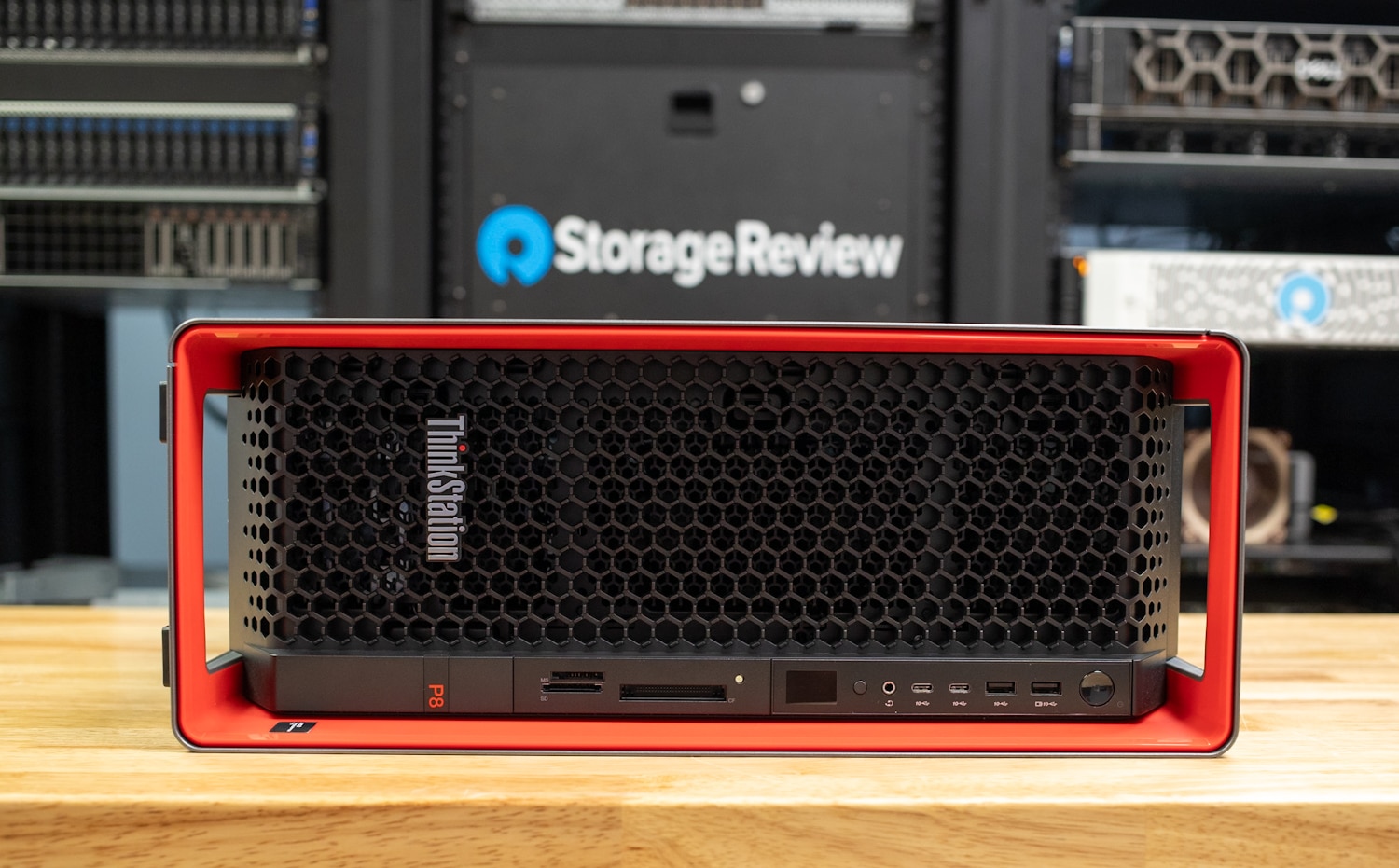
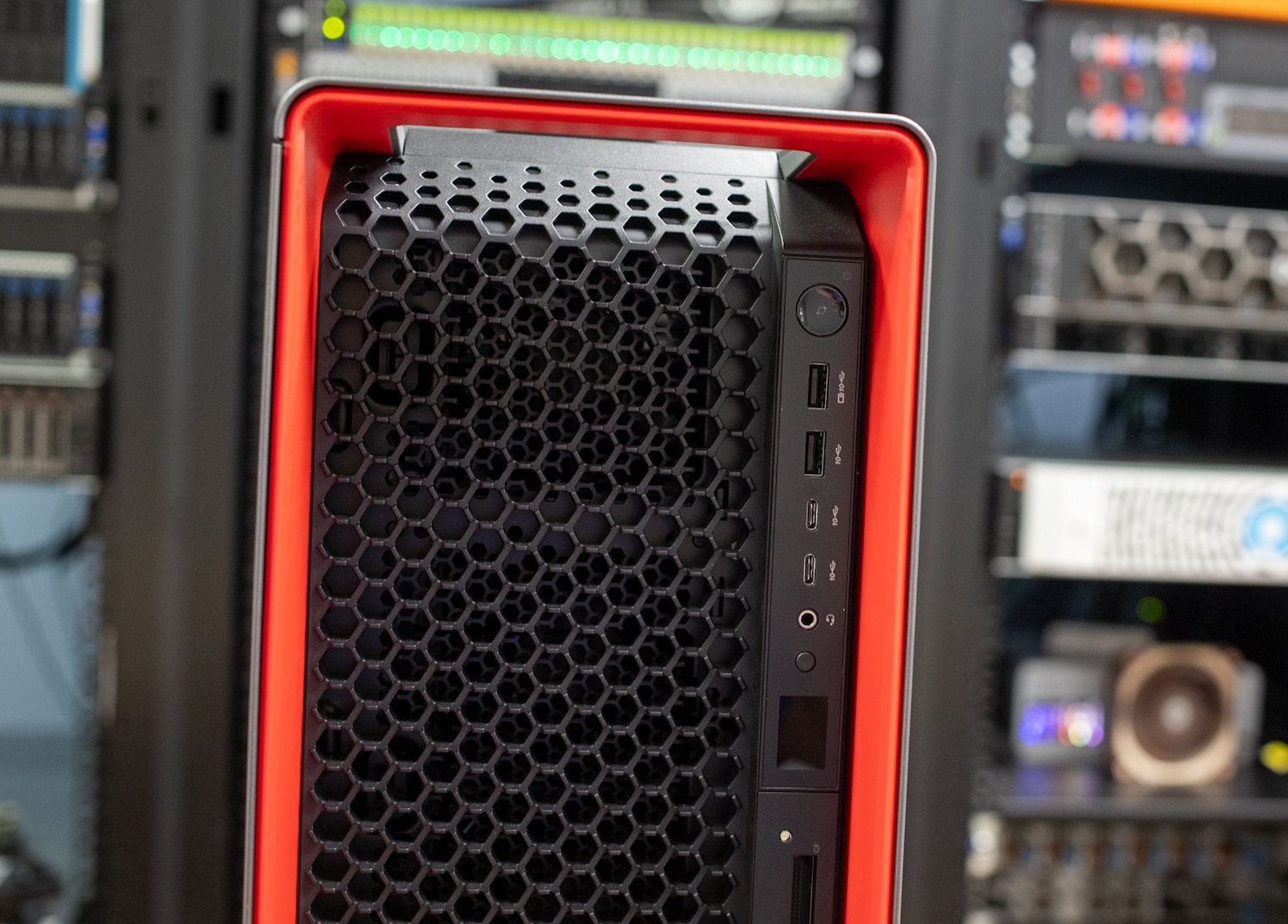
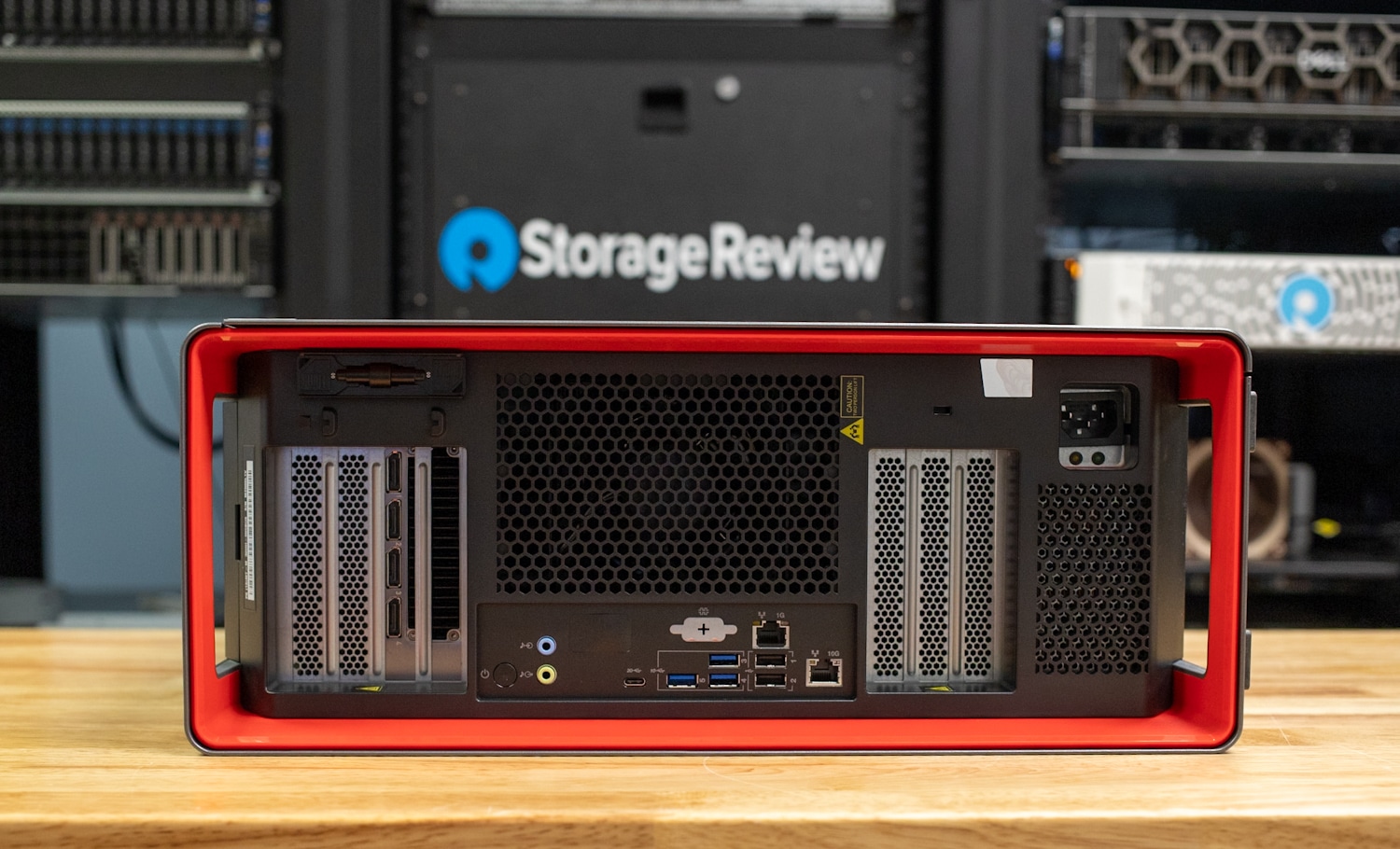
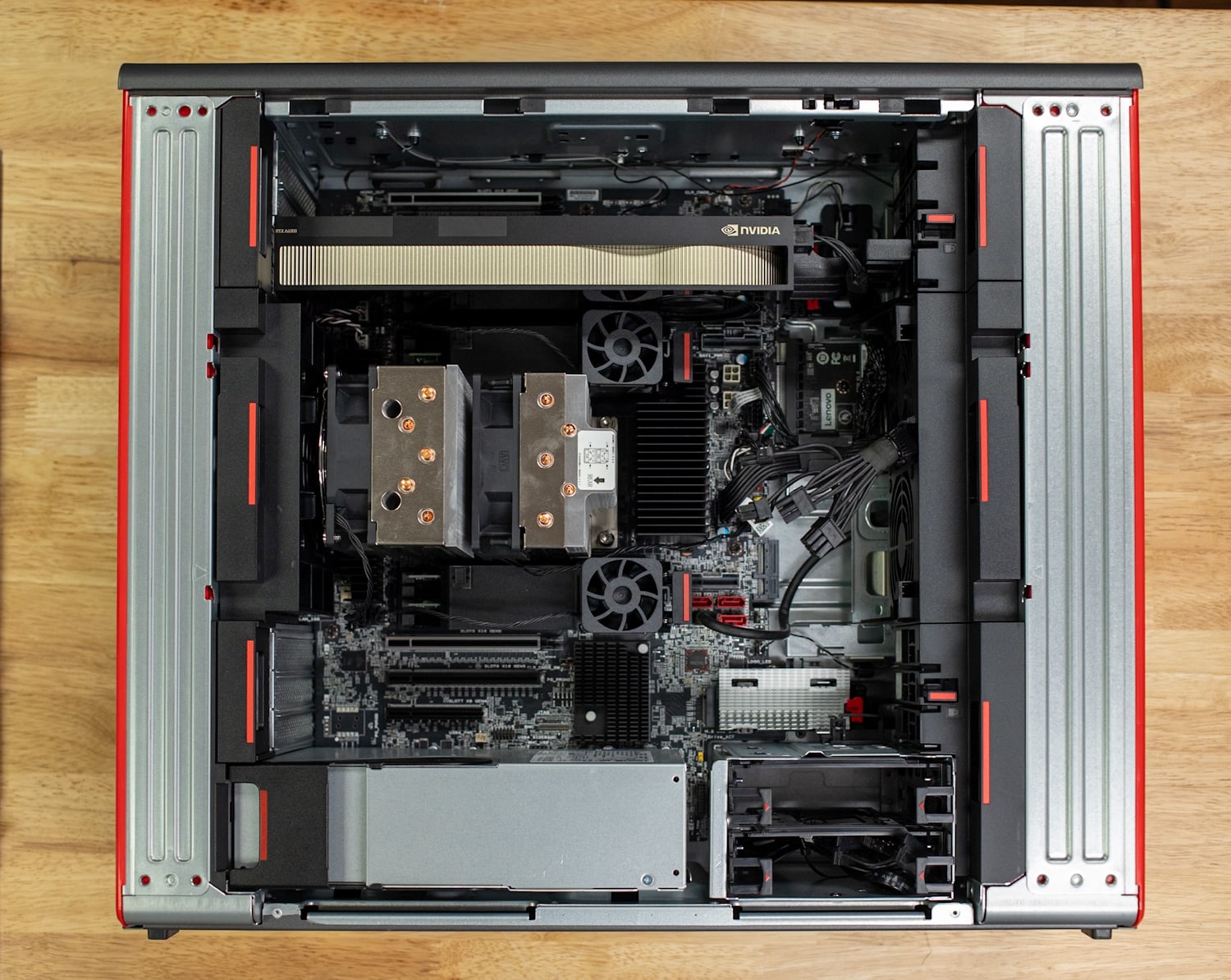
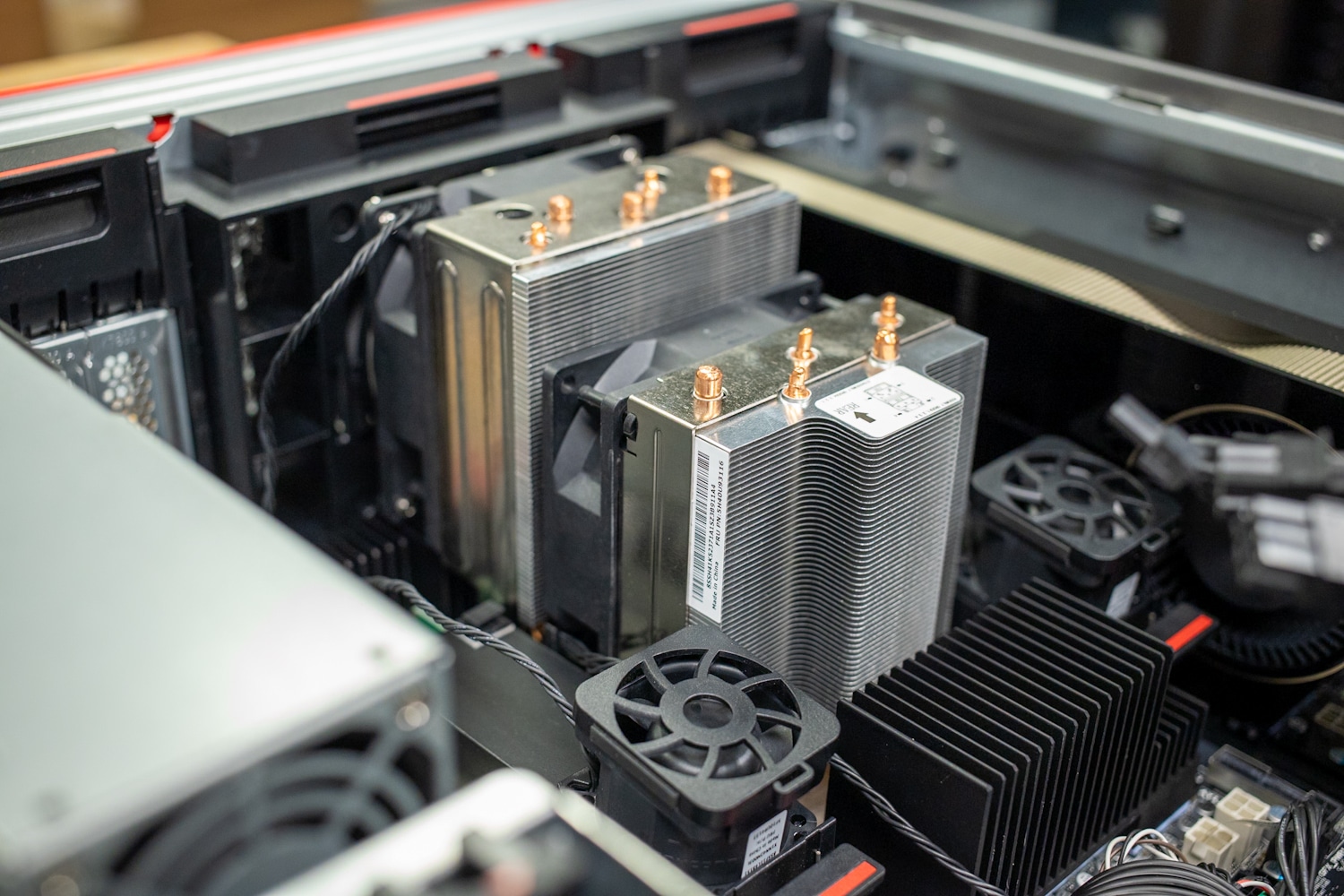
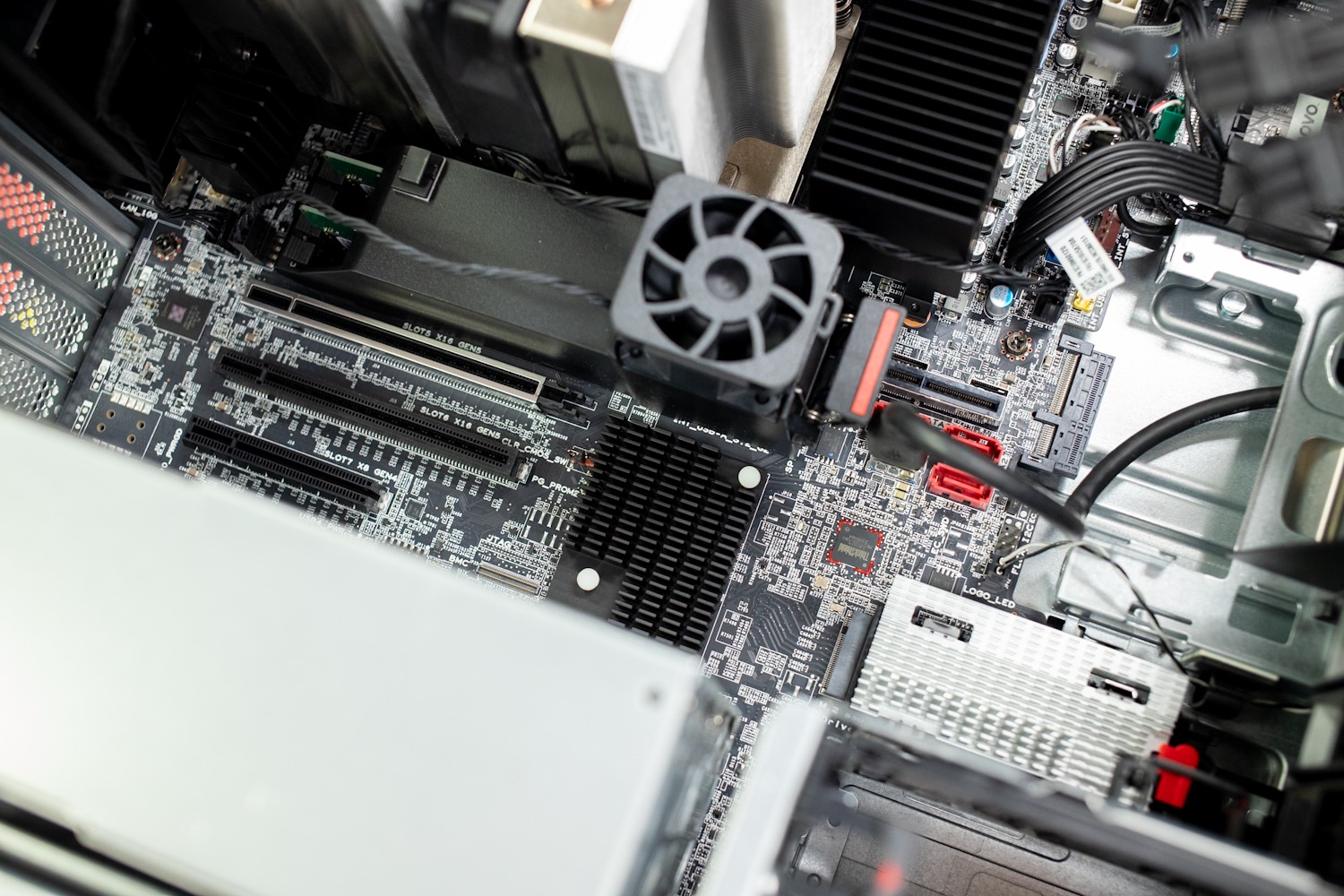
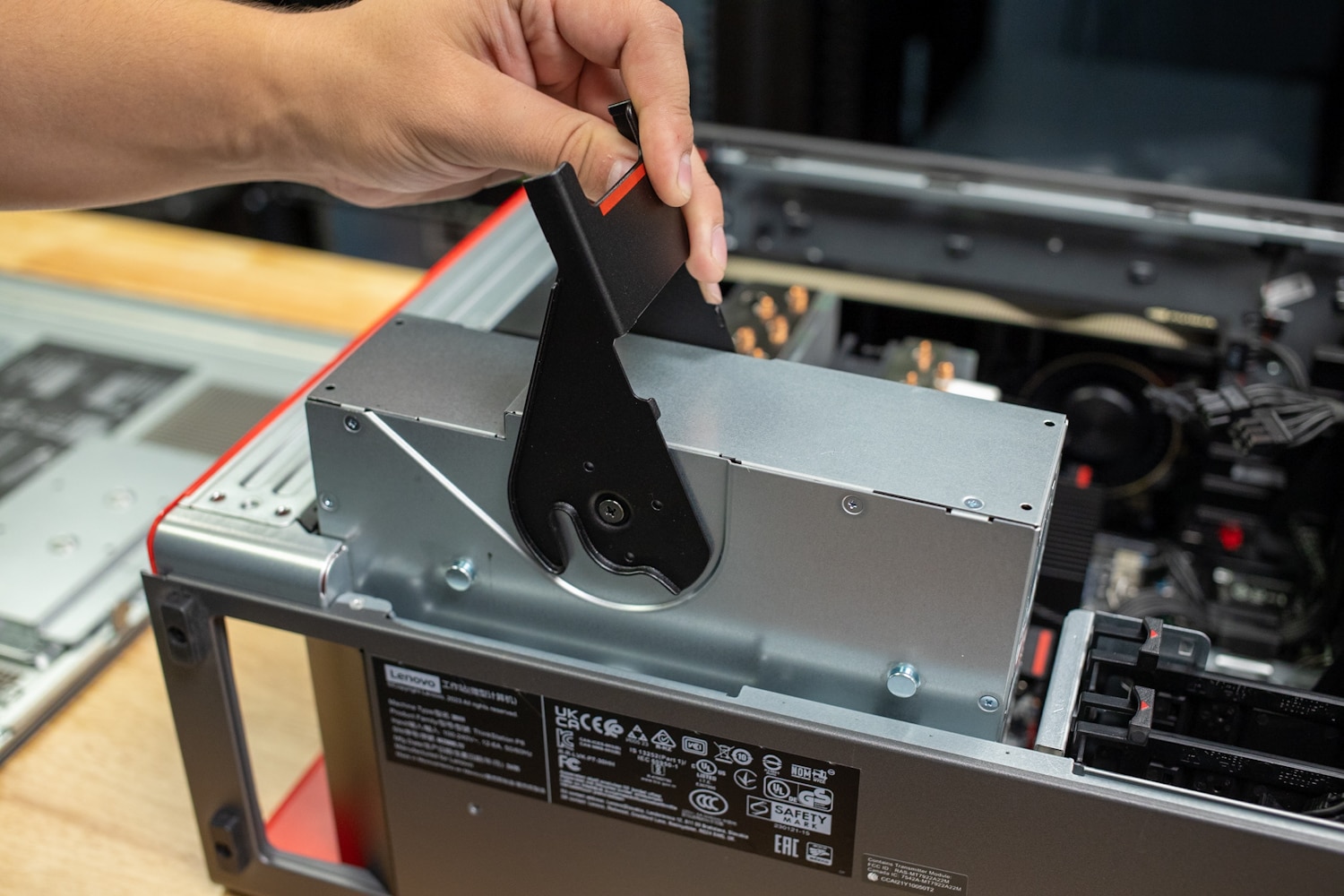
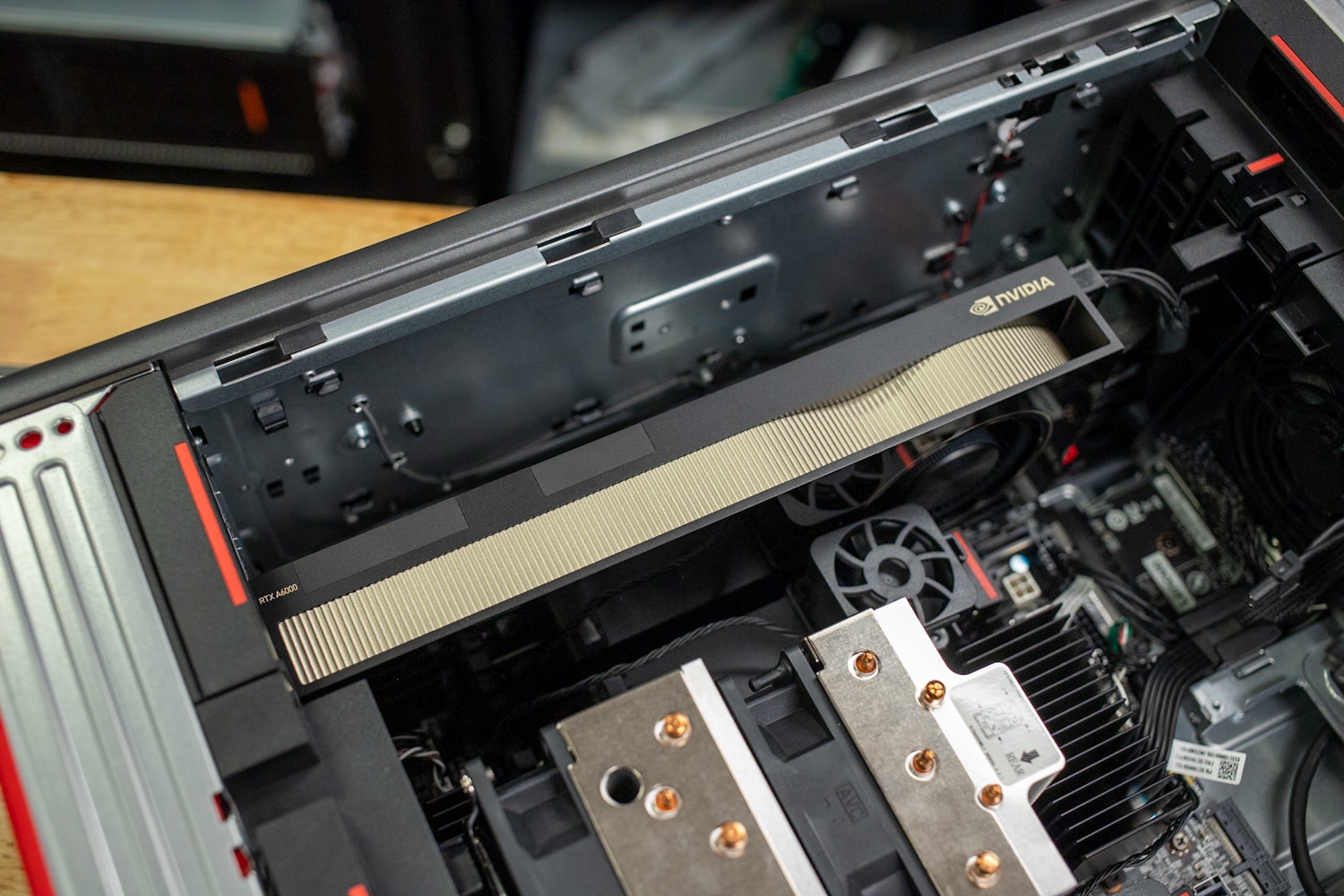
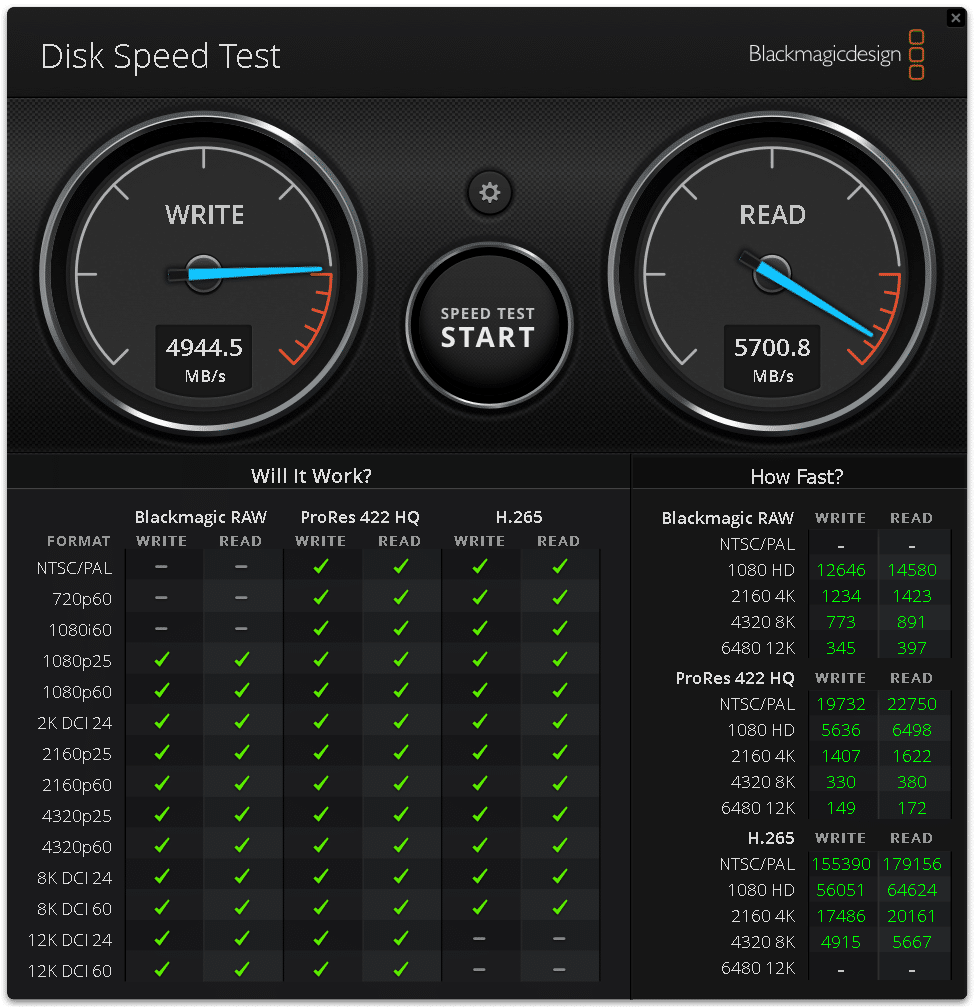 UL Procyon AI Inference
UL Procyon AI Inference